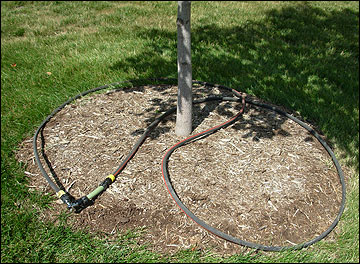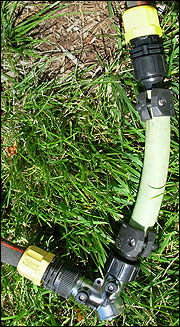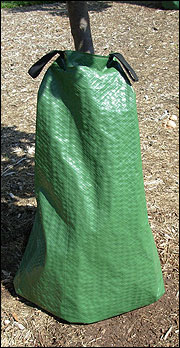Statistically, most of the Midwest receives sufficient precipitation during the average year to prevent undue stress to plants. However, precipitation is not distributed evenly during the growing season. In most years, stress during midsummer drought conditions causes significant mortality of newly planted trees and shrubs and reduces growth and aesthetic appeal of established landscape plants. In years when drought conditions are more prolonged, homeowners look to rescue measures to protect trees and shrubs, their largest landscape investment.
Most homeowners make some attempt to irrigate landscape plants during drought conditions. However, few of us do a very good job of maintaining the soil moisture in the optimal range. Early in the drought cycle, use of some form of drip irrigation allows homeowners to act preemptively to avoid drought stress on plants before possible restrictions on water use come into play. Sprinkler irrigation wastes water and encourages foliar diseases. It is also not very effective at getting water past turf roots so that it is available to roots of woody plants. Drip irrigation uses much less water than sprinkler irrigation and puts it more effectively into the root zones of trees and shrubs.
This publication describes the moisture requirements of newly planted as well as established trees and shrubs and introduces the principles of drip irrigation.
 Figure 1
Figure 1
Drip irrigation delivers water slowly and efficiently to the root zone of plants, maintaining soil moisture in a drought.
The danger of moisture extremes
It is common in Missouri to have above normal rainfall in April and May, leading to extended periods when the soil is saturated. These conditions, combined with the clay soils found in many landscapes, may lead to suffocation of deep roots even when plants are growing on slopes. Then, when the annual drought strikes, trees like sugar maple and pine are less capable than usual of coping with drought stress because their root systems are damaged. This situation may lead to a downward spiral in which a large tree, weakened by drought stress, is attacked by insects and diseases that normally pose little threat to plant health. Leaves may be sparse and smaller than normal, leading to a reduction in photosynthesis and a gradual starvation of stems and roots. This makes the tree even more vulnerable to attack by borers and wood decay fungi, sometimes leading to mechanical failure.
The above theory can be stretched to explain the decline of oak and hickory trees that often occurs two or three years after construction of a new home. In this case, however, the root damage is due to severing or crushing of roots during the construction.
To avoid triggering tree decline, plant trees in well-drained soils, avoid mechanical root damage whenever possible and water damaged trees carefully during droughts.
How to water a new tree
Until a new plant is able to establish roots in the soil surrounding the original soil ball, it is critical to keep the soil ball moist. It generally requires frequent light applications of irrigation water to achieve this goal without drowning the plant in a clay soil "bathtub." Generally the safest and most effective approach for getting a new tree or shrub through the first summer is to irrigate regularly by dripping a known quantity of water slowly into the root ball of the plant.
According to standards established by the American Nursery and Landscape Association, a 2-inch-caliper red maple tree should have a soil ball about 24 inches in diameter with a depth of about 16 inches. The total volume of such a soil ball would be equivalent to the volume of about 20 gallons of water. Assuming that the soil in the ball is a clay loam, the volume of water that could be held by the soil ball is about 25 percent of the total soil volume, or 5 gallons. On a single windy, 95-degree day in July, the leaves on a reasonably healthy, transplanted red maple tree the size of yours may transpire 2 or 3 gallons of water. Given the limited root growth into the backfill soil outside the root ball, the new tree may be suffering severe drought stress in just a few days. The challenge then becomes how to replenish the moisture in the soil ball without leaving it saturated for an extended period.
There are several common approaches to watering newly planted trees. One is to water by hand, applying water to the planting hole with a hose. Another is to allow the hose to trickle at the base of the tree for some period of time. There are two problems with these methods:
- The waterer usually has no idea how much water has been applied
- There is no guarantee that water that was applied actually went into the soil ball.
In some cases, not nearly enough water has been added. Much of the water applied may have run off or gone down a snake hole. In other cases, the planting hole fills with water and the soil ball stays saturated for several days. In either case, the plant may suffer severe moisture stress.
The best approach to watering a tree for the first year after planting is to use some form of drip irrigation that will wet the soil ball itself. To keep a 24-inch root ball moist but not saturated during drought conditions requires 2 or 3 gallons every four or five days. The simplest way to meet these needs is to poke a few nail holes in the sides of a 5-gallon bucket near the bottom, set the bucket next to the trunk and fill it with water every few days. A slightly more sophisticated method is to insert two or three one-gallon-per-hour drip emitters into a short length of plastic tubing that can be attached to the end of a hose with a hose fitting. This can be attached to an inexpensive electronic, battery-operated timer programmed to turn the water off after one or two hours of operation. Mechanical timers that run by water pressure are not designed for use with drip systems. Many nurseries, garden stores or mail order houses sell drip irrigation kits that can be adapted to this purpose. Also available commercially are special plastic pouches that wrap around the trunk of a young tree and provide drip irrigation through pinholes (Figure 2).
Besides the appearance of your plant, another way to gauge whether you are supplying the right amount of water is to probe the soil ball with a metal rod. If you are unable to push the rod easily more than a few inches into the ball, you are not applying enough water. If the rod slides easily all the way through the ball, you are overwatering. Drilling an 18-inch-deep hole next to the soil ball with a soil auger will allow you to check for standing water and to pump it out with a small, drill-powered siphon pump. With a little care, you can gradually wean your tree from its dependence on the original soil ball. Once it has sent some roots out into the surrounding soil, it will gradually recover from the shock of having up to 95 percent of its roots cut off when it was dug from its previous location.


Figure 3
Use a Y-adapter and a gender bender, right, to irrigate a tree uniformly with a soaker hose.
Irrigating established trees
In general, the larger a tree, the more drought-tolerant it will be. This is because a well-established tree has a massive root system, often extending four or five times the diameter of the drip line. Also, if the soil is not too dense, tree roots can grow many feet deep, tapping into subsoil moisture. In a drought year, however, when subsoil moisture has been depleted, trees lose this advantage and must compete with other plants for moisture near the surface. Sparse foliage, dieback or mortality of many large trees in the spring is evidence that the drought is already taking its toll before summer has even begun. While it is normally not necessary to irrigate established trees, it may be advisable to do some judicious watering to ensure survival of particularly valuable trees.
First, it must be understood that it will take a tremendous volume of water to replenish the soil moisture throughout the entire root zone of a large tree. If, for example, we assume that 8 inches of water will be required, then a single 30-foot-tall oak tree with a root system 100 feet in diameter would require 39,000 gallons of water. Using a sprinkler irrigation system attached to a garden hose delivering 5 gallons per minute, it would take five days of continuous irrigation to water this one tree. Obviously, it will not be possible to replenish the moisture reserve in the entire root zone of a large tree with irrigation. Fortunately, however, wetting even a small portion of a tree's root zone will greatly reduce drought stress.
Lawn irrigation typically has little impact on large trees. Most homeowners irrigate lawns frequently for a short period of time. While this practice maintains enough moisture in the upper 3 inches of soil to keep the turf green, it provides little water to tree roots. Unless the turf is shaded, tree roots cannot compete with the dense mat of turf roots near the soil surface. Maintaining a large mulched area under a tree or growing a less competitive ground cover, such as ivy, allows trees to use irrigation much more effectively.
An effective method to reduce drought stress for a large tree is to use a soaker hose of some type. For example, a 50-foot length of the type of hose that seeps from small holes can be attached at both ends to a Y-adapter on the end of a garden hose (Figure 3). Do this by making a "gender bender," a short piece of hose with female hose fittings on both ends. This provides a double soaker with reasonably uniform delivery over its 25-foot length. Laying this within the drip line, under a tree and running it for about one hour will wet a band about 2 feet wide with about 200 gallons of water. This should be equivalent to about a 6-inch rain over 5 percent of the root zone of a large tree. Repeating this procedure three or four times in different locations during drought conditions should significantly reduce drought stress without using an inordinate amount of water. Another technique that may help is to divert water from downspouts so that, during precipitation events, some of the diverted water soaks into tree root zones rather than running into storm sewers. Deep irrigation of shrub beds will also help nearby trees.
Drip irrigation basics
Drip irrigation is an excellent tool for getting trees and shrubs through a drought using a fraction of the water that would be required for sprinkler irrigation. If for example, a group of 10 shrubs within a 30-foot-diameter area were irrigated with a sprinkler, it would take 438 gallons of water to apply one inch of water to all the plants. At a delivery rate of 5 gallons per minute, it would take about 1.5 hours to apply this much water. However, if the same 10 shrubs are irrigated for one hour and fifteen minutes with a single drip line with 20 emitters each delivering 1 gallon per hour, it would require only about 25 gallons of water to do the job.
Among the advances in drip irrigation technology in recent years, compression fittings and pressure-compensating emitters greatly simplify the task of installing a drip system. While garden stores in more arid states commonly offer a full line of drip equipment, it is more difficult for Missourians to find all of the necessary components locally. In some cases it may be necessary to order the materials through a supply house. However, regardless of the source, the basic components of all drip systems are similar. These include a control valve, a supply line, laterals and emitters. Depending on the water supply and the size and complexity of the system, other necessary components may include filters, timers, pressure regulators and solenoid valves. In most cases, the store or supplier selling the equipment will have information describing the proper installation and operation of the system. In general, it is best to find a source offering more than just prepackaged kits. Almost invariably, additional fittings and emitters are needed to put the finishing touches on the system. For large systems irrigating dozens of trees and shrubs, it may be best to retain the services of an irrigation specialist.
 Figure 4
Figure 4
Drip irrigation systems wet the soil in different patterns depending on soil texture.
Once a drip system is installed according to instructions, it takes a little practice to learn how to use it effectively. The most important thing to remember is that water dripping slowly into the ground wets a balloon-shaped volume of soil (Figure 4). While most of the root zone of a drip-irrigated plant may have ample moisture, the soil surface may appear dry, tempting the irrigator to water too long. Using a hypothetical example, assume that one is watering a series of shrubs using a drip line with emitters each delivering 1 gallon per hour (gph). For a clay loam soil, a drip emitter would wet an area of approximately 2 square feet. Given that it takes 0.62 gallon of water per square foot to apply 1 inch of water, it will take 1.24 hours to apply 1 inch of water to the area wetted by that emitter. Emitters spaced about 18 inches apart in the line would wet a solid band of clay loam soil. Plants with larger root systems may need two or three emitters. So, using the rule of thumb that rainfall should be supplemented with irrigation to total about 1 inch per week, the plants on our hypothetical drip line should be in good shape if they are watered for a little more than an hour every week.
Do not operate a drip irrigation system without a timer. It is not possible to gauge the moisture content of the soil ball by observing the wetting of the soil surface. If the soil ball gets too wet, the tree will be under severe stress during hot weather.
The foregoing discussion is oversimplified. Optimum drip irrigation frequency will depend on the delivery rate of the emitters, the weather conditions, the soil type and other factors. However, if the manufacturer's recommendations are followed in installation, it will take relatively little time to learn how to use a drip system. And given the ease of operation, landscape plants will be more likely to receive regular and effective irrigation during drought conditions. The result will be healthier plants and relatively little water used.
 Figure 2
Figure 2